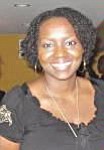By NICO SCAVELLA
Tribune Staff Reporter
nscavella@tribunemedia.net
A BAHAMIAN woman studying medicine in the United States has willingly become a test subject in a research designed to fight the spread of Ebola in the Western hemisphere, according to an international report.
The Baltimore Sun reported that Khandra Sears, a 33-year-old postdoctoral scholar in Baltimore, was recently injected with 100 billion particles of a chimpanzee cold virus that had been modified to resemble Ebola.
Additionally, it is reported that she will give researchers extensive amounts of her blood to test for antibodies that could potentially disable the virus.
For her participation, Ms Sears is to receive up to $1,000.
However, according to the article, on a recent visit to the research facility, Ms Sears’ body just wouldn’t bleed anymore. She was unable to fill the ninth and final vial researchers sought to fill.
Despite the obvious sacrifices and discomfort involved, Ms Sears said she did it for the sole purpose of lending a helping hand in the ongoing fight against the deadly virus.
“This was a way I could,” she told the Baltimore Sun. “Vaccine development is such an important process to take part in.”
Ms Sears is among 20 research subjects who have received the experimental Ebola vaccine in a study at the University of Maryland School of Medicine over the past two weeks, the Baltimore Sun said.
The vaccine itself cannot give the subjects Ebola. It contains proteins that fool the immune system into mistaking the harmless chimpanzee virus for Ebola.
According to the article, the researchers gave half the participants a dose containing ten billion particles, and the other half a dose with ten times as many particles. Ms Sears, along with another test subject, Andrea Buchwald, reportedly said they received the higher dose. The method assists researchers in learning how much vaccine a patient needs to create immunity, and how long that immunity lasts.
Despite not being directly exposed to the Ebola virus, the process is not without pain, however. According to the Baltimore Sun, the vaccine caused some side effects in some of the participants. Ms Buchwald said she came down with a fever of nearly 101 degrees hours after the vaccination. Both she and Ms Sears also said it left them exhausted.
Ms Sears is not a stranger to such conditions, however. In 2012, she reportedly participated in a study that helped show how much exposure to malaria it takes to cause infection - information that could eventually be used in clinical trials of vaccines for that disease.
Following that up with her brave participation in the Ebola vaccination trials, Ms Sears said that participating in clinical trials has given her a better understanding of what goes into solving some of the world’s worst epidemics.
“You just get a better idea of the research involved in developing these vaccines and what’s required,” she told the Baltimore Sun. “You realise they are really long-term projects.”
The Baltimore volunteers are reportedly among more than 200 people who have received a vaccine candidate developed at the National Institute of Allergy and Infectious Diseases, which is part of the National Institute of Health, in collaboration with drug maker GlaxoSmithKline.
A pilot study of the vaccine involving human subjects was conducted at the NIH in September. Since then, more trials have begun at the University Hospital of Lausanne in Switzerland, the University of Oxford, Emory University Hospital in Atlanta and among health workers in Mali, the Baltimore Sun said.
Ms Sears was born and raised in Nassau and is the daughter of former ambassador Joshua Sears. After high school she attended the Cave Hill, Barbados Campus of the University of the West Indies where she earned a Bachelor’s of Science degree in Microbiology.
Her studies have taken her to the American Red Cross Holland Labs in Rockville, Maryland, then later into the Graduate Programme in Life Sciences at the University of Maryland.




Comments
Use the comment form below to begin a discussion about this content.
Sign in to comment
Or login with:
OpenID